Ruben’s Tube
The Ruben’s tube is a classic physics apparatus to show that sound waves are primarily pressure waves. It can be considered to be an older version of the oscilloscope and gives a visual demonstration of standing waves with the help of flames.
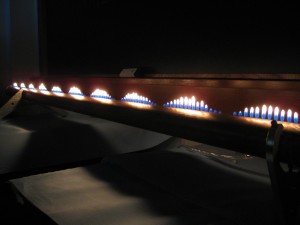
History and Original Composition
The Ruben’s tube was invented in 1905, by a German physicist named Heinrich Rubens, born in 1865. The original device consisted of a four-meter long section of a pipe with 200 holes of equal diameter placed uniformly along its length. The ends of the pipe were sealed, and an inflammable gas was pumped into it. Having no other way to escape, the gas came out of the holes and was then lit up to form flames of equal height.

Then, a loudspeaker was attached to one end of the device and sound was played into it when the heights of the flames changed depicting pressure differences set up within the tube due to the sound waves.
In 1866, another scientist by the name of August Kundt gave a similar demonstration of standing waves in the Ruben’s tube by placing sawdust in it. When a varying sound was played through it, the dust lined up showing node and antinode formation. Behn also claimed later that the flames used in this device can be used as indicators of pressure differences.
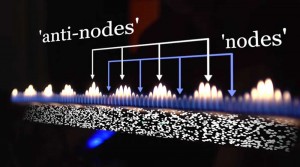
Explanation: How it Works
Sound is a longitudinal wave traveling in the form of compressions and rarefactions in the air. The compressions signify zones of high pressure and the rarefactions are low-pressure zones.
Since the Ruben’s tube is closed at one end, standing waves of sound are setup inside. According to Bernoulli’s Principle, the speed with which the gas comes out of the setup is a function of the pressure difference between the interior of the tube and the atmospheric pressure. Hence, at places of high-pressure differences the gas escapes out with high velocity and the flames shoot up. And, the places in the apparatus where the pressure differences are low, are characterized by short flame heights. The points of maximum pressure have the tallest flame and are known as crests. On the other hand, the points of minimum pressure having the shortest flames are known as troughs.
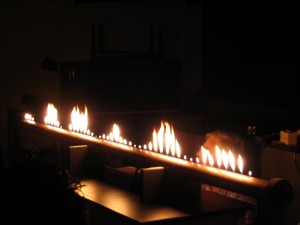
Theory
If we denote the frequency of sound as f, its speed in the medium as v and wavelength as λ, then these three parameters are linked together by the equation,
Knowing the values of f and λ, the velocity of sound in the gas can be determined.
Ruben’s Tube Risks and Safety Measures
- The tube uses inflammable gas like natural gas or propane as the medium, increasing its potential risk of explosion. So, it is better to be constructed and operated by an instructor. Also, it should be flushed with gas at least for 20 minutes before lighting to minimize the chances of an explosion.
- The gas supply to the tube should be properly adjusted so that the flames do not reach large heights.
- The structure is not supposed to be leaned against. Efforts should be made to keep the device parallel to the surface on which it is kept. The surface should be a clean one having no other object on it.
- There must be at least 1.5 m of clear air above the apparatus. Nothing is to be kept hanging or otherwise in that space.
- The lab or room where the device is kept is supposed to be very well ventilated to prevent any accumulation of flammable gas.
- In case of an explosion, the rubber sheaths or any other material coverings, which seal the two ends of the tube, are likely to be blown off first. Hence, no one should be allowed to stand near those parts. Students can stand along the length of the tube keeping themselves at a minimum distance of about 2 m from it. Wearing protective eye gear is advisable.
- Greater care should be taken if the gaseous medium consists of bottled gas, i.e., propane or butane, instead of methane because their gas pressures are higher, and they produce hotter flames. They also have a tendency to collect at the floor level.
- The arrangement can become tremendously hot. So, it ought to be operated for just 10 minutes out of every 30 minutes allowing it sufficient time to cool before handling or storing.
- The apparatus is supposed to be checked for gas leaks annually.
- The signal generator or loudspeaker should not be turned on or off while the gas is flowing into the tube. First a steady supply of gas in the tube is to be ensured and then the fire lit. Once all the flames are found to be of equal height, the signal generator is to be turned on.
- The frequency or volume of the signal generator is to be adjusted very slowly. Abrupt changes might cause unexpected changes in the flame height.
Ruben’s Tube Applications
The device is now used only as an experimental demonstration of acoustic standing waves in labs. Its use as a scientific instrument to study waveforms is obsolete now because an oscilloscope serves the purpose with greater accuracy and is more convenient to set up.
Many musicians and bands make the flames dance to their music for giving a unique audio-visual treat to their audience. Instead of a pipe, some use a cuboid that offers a larger surface area for the holes. This arrangement, known as Pyro Board is an improvisation of the classical structure of the tube and gives a 2D effect of the flames.
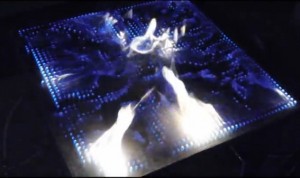
Singing stars have created a sensation by performing on themes like dubstep and Gangnam Style on the structure.
Although the device has only antique value now, it is one of those rare inventions of Physics which allows learners to grip core concepts of standing waves in a visually stimulating way by making the flames dance to the rhythm of sound. In that way, even in this age of digital oscillators, Ruben’s Tube is difficult to beat.
-
References
Article was last reviewed on Thursday, February 2, 2023

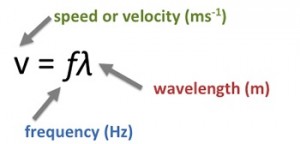






What is the practical use of Rubens tube in everyday life?
If it is only demonstrating sound waves as pressure waves,
this can easily be proved by a slinky and there would be no use of such apparatus.